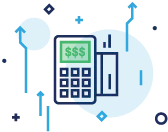TABLE OF CONTENTS

If you looked at your bank account and saw you were charged for “BANKCARD MTOT DISC,” you’re probably wondering where that came from. It also may have shown up as “MTOT DISC,” “BANKCARD MTOT,” or “MTOT DISC BANKCARD,” or potentially another similar variation.
In this article, we are going to discuss BANKCARD MTOT DISC: what it is, why you’re seeing it on your merchant statement, and where to find the breakdown of this charge.
What Is MTOT Disc?
MTOT Disc is a compounded abbreviation. MTOT stands for “merchant total,” and Disc stands for “Discount.” BANKCARD is the indication that this is a payment processing charge.
If you see “BANKCARD MTOT DISC,” “MTOT DISC BANKCARD,” or another variation, it is your monthly fee for payment processing. There are many payment processors that use the same descriptor, so you will need to contact your processor specifically for their exact descriptor.
Additionally, many articles on this topic will incorrectly label this as an “unfair charge” as an attempt to get your business to switch to their credit card processing. For example, they will say, “We don’t charge “BANKCARD MTOT” so switch to us!” In reality, “BANKCARD MTOT” is simply the descriptor that shows up for any payment processor using the FISERV/First Data network. Other processors’ fees may say something else on your bank statement, but they charge equivalent fees for their services.
MTOT Disc meaning
MTOT Disc can be confusing because, in most contexts, a “discount” is a good thing. However, in financial lingo, “discount” refers to a rate. A discount rate is a percentage charged, or the rate of return for the recipient, and not a percentage off of a price.[1]Corporate Finance Institute. “What is a Discount Rate?”. Accessed May 12, 2022.
Bankcard USA and MTOT Disc
With the inclusion of the word “bankcard,” many people incorrectly assume that they are being billed by Bankcard USA. Unless you have a specific merchant services relationship with the company, BANKCARD MTOT DISC is not a charge from Bankcard USA.
Bankcard MTOT Dep
If you happen to see “DEP,” know that it stands for “deposit.” If the descriptor has “MTOT” included, this is your merchant monthly total or month-end total. But if you don’t receive deposits on a monthly basis, you may not see this descriptor paired with “Dep.” More commonly, you’ll see “BTOT.” We’ll get into that one next.
Bankcard BTOT Dep
“BTOT” is an acronym that stands for “batch total.” This is a descriptor that should align with your daily batch deposits. While subtle, this is the major differentiation between BTOT and MTOT on deposits. It describes the frequency that you can expect to see your deposit, which depends on your processing activity.
Types of Bankcard MTOT Disc Fees
So now you may be wondering, how can I get a breakdown of the MTOT disc fees? The good news is that you should already have it. Your monthly merchant statement from your payment processor should show a total that matches the charge you see on your bank account. It will also break down how they came to that fee amount. Let’s break down some of the major categories you’ll likely see on your statement.
Monthly fees
At the end of the statement, you will probably see a breakdown of monthly fees. Monthly fees include a statement fee, on-file fee, PCI non-compliance fee (if you’re not already PCI compliant), optional services, etc.
Annual fees
You may also see an annual fee listed on your statement. If you see an annual fee, check recent statements to verify that it is an annual fee. Some PIN debit networks charge an annual fee of around $10, such as STAR, PULSE, and NYCE. Some payment processors also charge an annual fee for their services. If you have questions about your annual fees, contact your processor.
Processing and Authorization fees
The largest chunk of your fees will come from your payment processing activity throughout the month. You’ll see discount rate-based fees, so percentage-based charges on your payment processing volume. These credit card processing fees are reviewed with you when you first open your merchant account.
You’ll also see authorization fees, or a per-unit charge based on the total number of authorized transactions you ran throughout the month.
No matter how complicated it looks, you can come to make a bit more sense of it by getting your effective rate. To get to your effective rate, take your total BANKCARD MTOT DISC and divide it into your total processed volume for the month. On average, this should total between 2% and 4%.
Your Effective Rate:
Total number of fees you pay in a month ÷ total sales volume for that month × 100 = Effective Rate Percentage
Is Bankcard MTOT Disc Open about Fees?
To get a breakdown of your BANKCARD MTOT DISC fees, pull up your merchant account statement for the month. If you don’t get it physically printed and mailed to your business address, you may be able to pull your statement from your merchant portal with your payment processor.
Does the Law Require Disclosure of Fees?
Yes. Federal law requires that all financial institutions disclose the fees that they charge. The law states:
Fees (§ 230.4(b)(4)) An institution must disclose the amount of any fee that may be imposed in connection with the account (or an explanation of how the fee will be determined) and the conditions under which the fee may be imposed.[2]Federal Reserve. “Regulation DD Truth in Savings”. Accessed May 12, 2022.
Can Merchants Reduce MTOT Disc Fees?
Reducing “MTOT Disc” fees is a matter of reducing your overall costs for payment processing. There are a few ways to go about this.
- Speak to your payment processor: Your payment processor assesses a rate review on your merchant account and determines a new rate based on your processing history. However, a rate review will not guarantee a lower rate.
- Reduce double authorizations: A common practice with bars and restaurants is doing an authorization hold. This happens when you authorize a transaction to open a tab and reauthorize a second time for the final amount when you close out the tab. Reducing authorizations will cut costs.
- Interchange optimization: You may be skipping prompts when you process transactions, leading your transactions to qualify for higher rates than they need to. Interchange optimization tactics can help you save money each month.
There are plenty of tactics you can use to save you from extra costs.

How to Eliminate MTOT Disc Fees
Remember, this is simply a bank descriptor that identifies your monthly fees for processing credit and debit cards. Unless you quit accepting payment through credit cards, you cannot eliminate MTOT fees. Switching to another processor may change the descriptor for this charge on your bank account but you will still be charged monthly services for whichever processor you use.
Final Thoughts on MTOT Disc Charges
MTOT Disc charges seem less confusing once you know what the charge is for. Every payment processor charges a version of BANKCARD MTOT DISC for monthly services. We recommend getting familiar with credit card processing to know more about who charges these fees and why they are charged.






